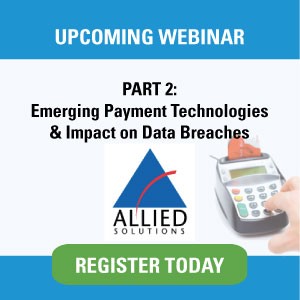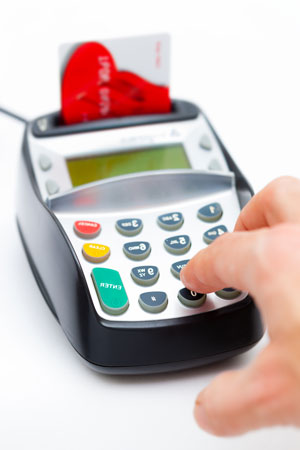What Credit Unions Need to Know About the Rise of Chip and PIN and Risk
According to the Federal Reserve, Chip and PIN technology involving a secure microchip used with a numeric code makes transactions about 700 times more secure than older payment methods.
Is Chip and PIN technology a priority at your credit union in 2015?
Join Ann Davidson, VP of Risk Consulting, Allied Solutions and Joe Majka, Vice President & Chief Security Off icer, Verifone Inc. on March 4th to learn about Chip and PIN technology and other emerging payment solutions (e.g., Apple Pay, tokenization, etc.) that can help your credit union reduce the risk of data breaches.
icer, Verifone Inc. on March 4th to learn about Chip and PIN technology and other emerging payment solutions (e.g., Apple Pay, tokenization, etc.) that can help your credit union reduce the risk of data breaches.
Ann advocates that credit unions seize the golden opportunity to reduce risk through the adoption of Chip and PIN technology and shares 5 things you need to know about the impact of the rise of Chip and PIN:
CHIP and PINâs Golden Opportunity
Chip-and-PIN cards, also called EMV (Europay, Mastercard, Visa), or smart cards, utilize a computer chip embedded in the card to authenticate transactions. When this card is inserted into a chip-enabled reader to make a purchase, the chip on the card communicates with the reader by sending a one-time, dynamic code unique to that transaction.
Implementing Chip and PIN card technology prior to October 1st, when new fraud liability rules take effect will help your credit union:
- Stop counterfeiting: Makes it impossible for criminals to create counterfeit cards with stolen data because Chip and PIN cards generate a one-time dynamic code that changes with each transaction.
- Reduce data breach and fraud exposure: Decreases your credit unionâs breach and fraud exposure when the physical card is used since Chip and PIN technology security far exceeds magnetic stripe technology.
- Save time and resources: Cuts the time and resources used by your credit union to process fraud claims
 and card reissues associated with card data compromises.
and card reissues associated with card data compromises. - Get a reputation boost: Builds your credit unionâs reputation for member satisfaction, given that consumers are becoming more aware of available payment security options.
- Facilitate easier international travel payments for members: Makes international travel payments easier in some cases. Much of the world, including Europe, Asia, and Canada, has already converted to chip technology and some international merchants and ATMs no longer accept magnetic stripe cards.
5 Things You Need to Know About Chip and PIN:
- If your credit union has not issued your members a Chip and PIN card, but a merchant has the new Chip and PIN technology, your credit union is held liable when fraud occurs.
- If you do not have chip-enabled cards by October 1st, you may be targeted by criminals and may have increased risk exposure to magnetic stripe fraud.
- Consider upgrading or replacing your ATM terminals to accept Chip and PIN technology before the card associationsâ fraud liability shifts occur in 2016 and 2017.
- Credit unions should continue to deploy multiple layers of protection and enhance existing fraud detection systems to combat payment fraud in both the âcard-presentâ and âcard-not-presentâ environments.
- Chip-and-PIN does not address card-not-present fraud (i.e., online, mail, telephone, or lost/stolen card fraud).*
Increase your credit unions financial stability, reputation, and member/customer base by seizing the golden opportunity to get rid of risk through Chip and PIN technology Chip in 2015.
Get the knowledge your credit union needs by registering today for Allied Solutionsâ Emerging Payment Technologies & Impact on Data Breaches webinar on Wednesday, March 4, 2015.
Presented by Allied Solutions, LLC and NAFCU Services, this webinar is offered at no cost to the credit union community. *Working with Allied Solutions to establish risk management procedures and get cyber liability protection can help mitigate this risk.
Â
